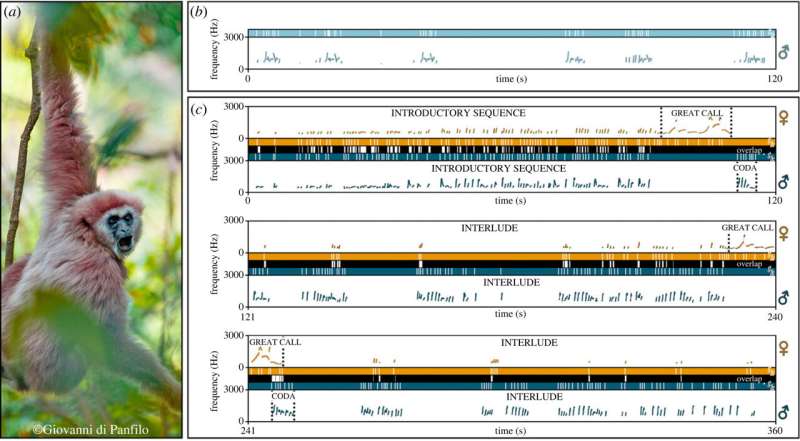January 13, 2023 report
This article has been reviewed according to Science X's editorial process and policies. Editors have highlighted the following attributes while ensuring the content's credibility:
fact-checked
peer-reviewed publication
trusted source
proofread
Singing gibbons found to be more rhythmic when performing duets

A team of researchers at the University of Turin, working with a colleague from the Max Planck Institute for Psycholinguistics and another from Aarhus University and The Royal Academy of Music, has found that the lar gibbon tends to be more isochronous (repeating notes more regularly) when singing as part of a duet with a member of the opposite gender. The research is published in the journal Proceedings of the Royal Society B: Biological Sciences.
The researchers recorded and studied songs performed by lar gibbons (also known as white-handed gibbons) living in a wildlife sanctuary in Thailand and a zoo park in Italy. Lar gibbons, they note, are among the few singing primates. Their work was part of an effort aimed at learning about the origins of rhythm in humans. Prior research has shown that not only do both genders of lar gibbons sing, they sometimes do so together as duets.
In all, the researchers made 215 recordings of songs voiced by 12 gibbons. Their analysis consisted of labeling notes making it possible to discern patterns, particularly those that were repeating. They also measured the intervals and the intertwining of notes as duets occurred.
The researchers found evidence of rhythm in all of the songs on their recordings, noting that they were in many respects similar to rhythm in human songs. They also found differences in rhythm based on gender—males tended to sing with more beats when singing with a female partner. During duets, the researchers found that notes sung by the male and female singers overlapped approximately 16 to 18% of the time, which they note is greater than chance.
The researchers also found that during duets, the males tended to sing more than the females, which they discovered meant that the females sang fewer notes when singing with a partner. This, they suggest, was evidence of rhythm playing a social role with the apes.
The researchers suggest that rhythmic ability in apes may have evolved as a means for coordinating vocalisms between genders. They also note that it is still not known if the last common ancestor between primates had similar abilities or if they evolved independently.
More information: Teresa Raimondi et al, Isochrony and rhythmic interaction in ape duetting, Proceedings of the Royal Society B: Biological Sciences (2023). DOI: 10.1098/rspb.2022.2244
Journal information: Proceedings of the Royal Society B
© 2023 Science X Network


















